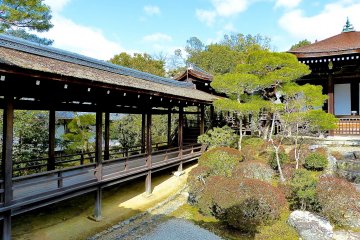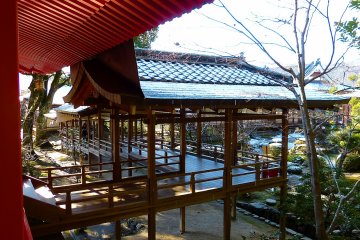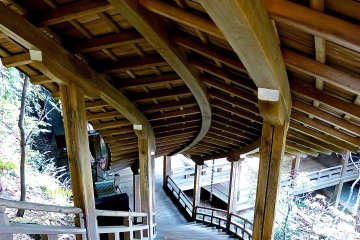
Kyoto Ninna-ji Temple, Omuro Palace
Tomoko KamishimaNinna-ji Temple, established in 888, is a balanced blend of aristocratic elegance and Buddhism simplicity. Its zig-zagging wo...
<p>Japan's Heian Period (794-1185) was an age of aristocracy. Their refined taste found its way into the design of temple buildings and gardens. The buildings often had no walls, but instead latticed shutters or sliding doors all around. When the shutters or doors were completely opened, the inside of the rooms became a part of the outside world. Outside roofed corridors connecting each building were also a place where they could touch nature, enjoy the gardens, and breathe and feel fresh air, yet be protected from rain, snow and strong sunshine. Noblemen really enjoyed the seasonal change of the gardens, and the comfortable touch of the wood of these impressive outside corridors.</p> <p>The temples covered in this series (by Tomoko Kamishima) were all established in the Heian Period, and are admired for the arrangement of their beautiful corridors:</p> <p><strong>Eikan-do Temple (established in 853)</strong>: Excursion through a collection of vertical corridors, leading up to higher levels</p> <p><strong>Daikaku-ji Temple (established in 876)</strong>: Excursion through a labyrinth of long horizontal corridors</p> <p><strong>Ninna-ji Temple (established in 888)</strong>: Zigzag corridors connecting sand and pond gardens</p> <p><strong>Shoren-in Temple (established in 1150)</strong>: Horseshoe corridors facing three gardens</p>

Ninna-ji Temple, established in 888, is a balanced blend of aristocratic elegance and Buddhism simplicity. Its zig-zagging wo...

Kyoto Shoren-in Temple: Enjoy the three gardens stretching out of its horseshoe shaped corridors.

Daikaku-ji Temple, located in the northwest suburbs of Kyoto, contains the same design elements of the ancient Imperial Palace.

Eikan-do Ttemple has fascinating vertical corridors that bring visitors on an excursion up and down and around the entire tem...